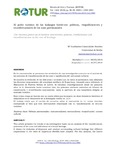Mostrar o rexistro simple do ítem
El poder turístico de los hallazgos históricos: políticas, resignificaciones y transformaciones de los usos patrimoniales
| dc.contributor.author | Comendador Sánchez, Mª Auxiliadora | |
| dc.date.accessioned | 2019-03-01T10:03:07Z | |
| dc.date.available | 2019-03-01T10:03:07Z | |
| dc.date.issued | 2018 | |
| dc.identifier.citation | Comendador Sánchez, M. A. (2018). El poder turístico de los hallazgos históricos: políticas, resignificaciones y transformaciones de los usos patrimoniales. ROTUR. Revista De Ocio Y Turismo, 12(2), 80-98. https://doi.org/10.17979/rotur.2018.12.2.3460 | es_ES |
| dc.identifier.issn | 1888-6884 | |
| dc.identifier.uri | http://hdl.handle.net/2183/22035 | |
| dc.description.abstract | [Resumen] En la comunicación se presentan los resultados de una investigación centrada en el análisis de los procesos de transformación de los usos y significados del patrimonio cultural.Se muestra la evolución de los discursos y acciones que, en torno al patrimonio, han adoptado las distintas corporaciones del municipio sevillano de Espartinas, tomando como referencia el Monasterio de Nuestra Señora de Loreto. Se estudian cronológicamente desde los primeros años de la democracia hasta nuestros días, las primeras acciones centradas en labores de conservación y rehabilitación monumental, hasta la apertura de una hospedería dirigida al mercado turístico.Esta última etapa se vincula con un nuevo relato que incorpora un descubrimiento histórico: el alojamiento en el Monasterio de la Embajada Keicho en 1614.El trabajo revela que el cambio de narrativa sobre el monasterio es un nuevo atractivo incorporado al bien que está directamente relacionado con su transformación en recurso turístico | es_ES |
| dc.description.abstract | [Abstract] This article presents the results of an investigation based on an analysis of the transformation processes of the uses and definitions of cultural heritage.It shows the evolution of discourse and conduct surrounding cultural heritage that different corporations in the town of Espartinas (Seville) have adopted. For this analysis, the Loreto Monastery was used as a reference point, due to it being a clear example of this heritage transition that begun with the first activities, focused on conservation and monumental restoration works, until the opening of a hostel aimed at tourists in the convent has been studied chronologically.This last stage is linked with a new discover: the 1614 arrival and subsequent stay of the Japanese Keicho Embassy at the monastery.The study reveals that the change in narrative surrounding the monastery is a new attraction incorporated into the site that is directly related with its transformation into a resource for tourism | es_ES |
| dc.language.iso | spa | es_ES |
| dc.publisher | Universidade da Coruña | es_ES |
| dc.relation.uri | https://doi.org/10.17979/rotur.2018.12.2.3460 | |
| dc.rights | Atribución-CompartirIgual 4.0 España | es_ES |
| dc.rights.uri | http://creativecommons.org/licenses/by-sa/4.0/es/ | * |
| dc.subject | Políticas patrimoniales | es_ES |
| dc.subject | Monumentalismo | es_ES |
| dc.subject | Mercantilismo | es_ES |
| dc.subject | Resignificación | es_ES |
| dc.subject | Turismo cultural | es_ES |
| dc.subject | Political heritage | es_ES |
| dc.subject | Monumentalism | es_ES |
| dc.subject | Commercialism | es_ES |
| dc.subject | Redefinitions | es_ES |
| dc.subject | Cultural tourism | es_ES |
| dc.title | El poder turístico de los hallazgos históricos: políticas, resignificaciones y transformaciones de los usos patrimoniales | es_ES |
| dc.title.alternative | The tourism potential of historic discoveries: politics, redefinitions and transformations in the use of heritage | es_ES |
| dc.type | info:eu-repo/semantics/article | es_ES |
| dc.rights.access | info:eu-repo/semantics/openAccess | es_ES |
| UDC.journalTitle | ROTUR. Revista de ocio y turismo | es_ES |
| UDC.volume | 12 | es_ES |
| UDC.issue | 2 | es_ES |
| UDC.startPage | 80 | es_ES |
| UDC.endPage | 98 | es_ES |
| dc.identifier.doi | https://doi.org/10.17979/rotur.2018.12.2.3460 |






